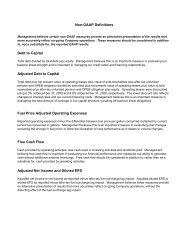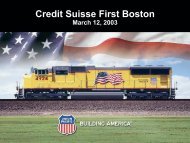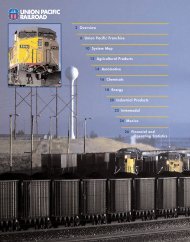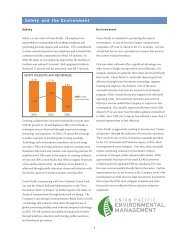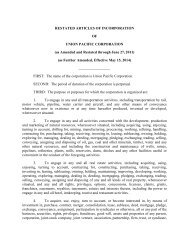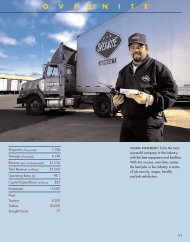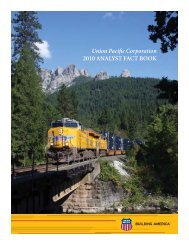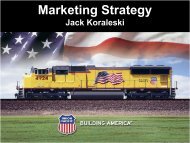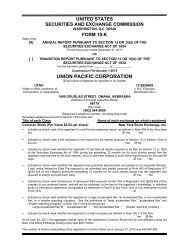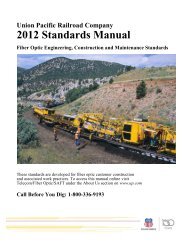AutomotiveCommodity Profile<strong>2008</strong> CarloadsShipments of fi nished vehicles and automotive parts and materialsgenerated 8 percent of <strong>Union</strong> Pacifi c’s <strong>2008</strong> freight revenue.Finished vehicles accounted for 77 percent of this revenue,with the remaining 23 percent coming from the movement ofautomotive parts and materials.<strong>Union</strong> Pacifi c’s franchise provides excellent accessibility to allmajor markets west of the Mississippi River for delivery of fi nishedvehicles to the manufacturers’ dealer networks. UP continuesto be the largest automotive carrier in the western U.S., directlyserving six vehicle assembly plants. Service is also provided to38 automotive distribution facilities directly or through short linerailroads. Additionally, connections to six West Coast ports andthe Port of Houston accommodate both imported vehicles andvehicles moving to and from Hawaii and Alaska. <strong>Union</strong> Pacifi calso receives and delivers a signifi cant number of vehicles throughinterchange with railroads in Mexico, Canada and the U.S.U.S. new light vehicle sales declined to 13.2 million vehicles in<strong>2008</strong>, down 18 percent from 2007 levels. North American lightvehicle production for the year was down 16 percent to 13.0million units. UP’s fi nished vehicle shipment revenue declined11 percent while carloads were off nearly 23 percent in <strong>2008</strong>.Although auto parts and materials volume decreased 13 percentfrom 2007, pricing actions and increased fuel surchargesincreased revenue by 3 percent year-over-year.Automotive Line Density MapInternational 7%Mexico 44%Domestic 49%Assembled Autos 60%Automotive Materials 40%<strong>Union</strong> Pacifi c handled more than 75 percent of the automotivecarload business in the western U.S. in each of the last twoyears. Changing dynamics among manufacturers in the industry isexpected to affect fi nished vehicle shipments as the manufacturerswork to keep or gain market share. The Domestic Big Threeincurred a market share loss during <strong>2008</strong>. Collectively they holdabout 48 percent of the new light vehicle market share in the U.S.Toyota, Nissan and other non-Detroit manufacturers have domesticmanufacturing capabilities and import a signifi cant number ofvehicles via West Coast ports. <strong>Union</strong> Pacifi c faces competitionfrom trucks for the fi nished vehicles imported through the WestCoast and destined for western automotive dealerships.Nearly 44 percent of UP’s automotive shipments move either toor from Mexico. This amount includes fi nished vehicle carloads aswell as parts and materials moving in intermodal or boxcar service.<strong>Union</strong> Pacifi c handles more than 85 percent of all automotivetraffi c into and out of Mexico. During <strong>2008</strong>, Mexico parts andmaterials shipments decreased 10 percent while fi nished vehiclemoves decreased 8 percent.Lane density based on carloadings. Line thickness depicts traffi c density.UP launched new product offerings in <strong>2008</strong> with the new Unileveland AutoMax cars. The Unilevel railcars are designed to effi cientlyhandle oversize products, while the AutoMax can convert from atri-level to a bi-level confi guration. The AutoMax’s ability to handledifferent vehicle sizes positions <strong>Union</strong> Pacifi c to support futurevehicle market trends. Also, the Railroad introduced a long-termvehicle storage program to help alleviate customers’ accumulatinginventory issues in today’s challenging market.15
Automotive2009 Market DriversU.S. light vehicle sales are expected to decline in 2009, continuinga trend that began in 2005. Further, manufacturers’ extendedplant shutdowns and shift reductions are negatively impactingproduction volumes. UP is primarily a destination hauler of fi nishedvehicles and has a diverse customer base that includes importand transplant manufacturers, which helps mitigate the effects oflower Domestic Big Three vehicle sales. Additionally, the Railroadis engaged in monitoring the development of distribution plans forimports from China and India. The Company is implementing anactive sales strategy for China to handle the expected import partsand vehicle volume.Participation by Chrysler and General Motors in the TroubledAsset Relief Program (TARP) may have indirect consequencesfor UP. Failure under this program could result in bankruptcy orcorporate restructuring. However, success may allow for thecontinuation of current relationships and contracts, and, therefore,<strong>Union</strong> Pacifi c is closely monitoring these matters.Traffi c to and from Mexico is also expected to decline as thefi nancial turmoil impacts the global economy. Shipping fi rmscontinue to look for opportunities to improve asset utilization. UP isseeking to develop import business which would access rail fromWest Coast ports, bypassing the Panama Canal and subsequentEast Coast port originations.UP is making infrastructure improvements across its system tohandle profi table traffi c growth. Improvements at Portland, OR,Houston, TX, and Chicago, IL are directed at the automotivebusiness. Also, continued implementation of the vehicle inventorydwell system will help ensure a high level of inventory accuracyand effi cient asset utilization.The Railroad capitalizes on its strong interline carrier alliances tosecure opportunities for automotive parts and materials. Theseopportunities include boxcar direct and moves bundled with crossdock truck-to-rail and rail-to-truck shipments.Additional growth opportunities exist with the Railroadsubsidiaries: Insight Network Logistics, Insight Network Transportand <strong>Union</strong> Pacifi c Distribution Services (UPDS). These companiesJulie Krehbiel,VP & GM AutomotiveHow has your team adjusted to the current economicsituation?Although economic conditions are affecting automotive carloads, UPis well-positioned over the long term with a broad base of customers.With a significantly weakened economy, it is very important tostrengthen the automotive service network by improving transit times,ensuring consistency, and incorporating transportation efficienciesinto the delivered product. In <strong>2008</strong>, gateway changes were madeand product was shifted to more strategically placed auto ramps.The Railroad also leveraged its intermodal network to maintaincustomer service despite lower volumes. In addition, the first everinterline co-load capability was launched with the Norfolk Southern(NS) by loading Chrysler and Ford vehicles together on the samerailcars. This approach allows the original equipment manufacturersto reduce vehicle dwell time at the load and unload facilities. In fact,the Ford-Chrysler interline move is yielding a 20 percent reduction inorigin dwell time. These efforts improve the Company’s economics andbenefits customers as well.What is the biggest opportunity in your business group overthe next 2 to 3 years?Many of UP’s opportunities are for organic growth associated withthe existing traffic base. The Railroad holds a market share of morethan 75 percent of all vehicles moving in the western U.S by rail.Our unparalleled automotive ramp network, including facilities in sixof the top ten fastest growing U.S. states, is expected to facilitatemarket growth once the overall industry rebounds. Parts opportunitiescontinue as production parts convert from over-the-road to intermodaland boxcar rail service. <strong>Union</strong> <strong>Pacific</strong> is also looking at non-traditionalmarkets such as service parts, mini-cars and European manufacturers.We reallocated sales resources in late <strong>2008</strong> to focus on these areasas well as production parts, to offset the current vehicle marketweakness. The co-load capability launched in <strong>2008</strong> is expected tofacilitate expansion of our footprint in the used car arena through jointefforts with Insight Network Transportation, a UP subsidiary and usedcar transportation broker. For the long term, we also see significantopportunities associated with vehicles assembled in China and India.We are positioning our network accordingly by aligning with keysteamship lines, ports and transportation partners.offer supply chain logistic services for major automotivemanufacturers. Insight Network Transport is making inroads intothe used car remarketing area by providing management andcoordination services for vehicle auction companies and rental carfi rms. Marketed jointly with UP’s rail services, these subsidiariescan assist manufacturers in meeting customers’ changinginventory needs and provide continued growth opportunities. Infact, <strong>2008</strong> revenue in this area was up 20 percent from 2007, andthis growth trend is expected to continue in 2009 and beyond.16



